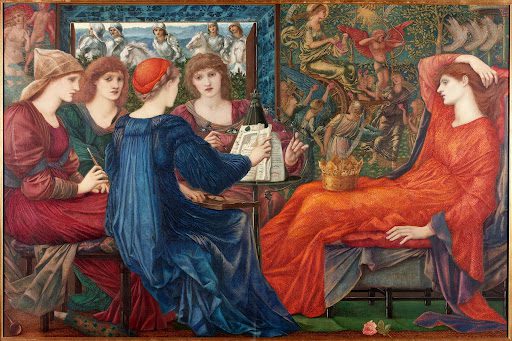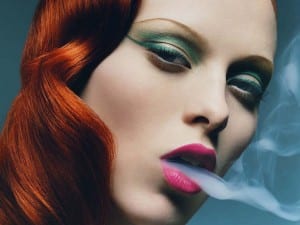Review by Laura E. Barone, a candidate for the MA in Art History at Richmond the American International University in London.
The Victoria and Albert’s major spring exhibition, The Cult of Beauty: The Aesthetic Movement 1860-1900 is decadent, comprehensive, and seamlessly integrated into the setting and approach of the V&A. A deliberate reaction against the codes and visual gloom of the Victorian era, the Aesthetic movement approached art and beauty as valid ideals in their own right, and aimed to express this ethos through an entire lifestyle.
Aestheticism centred around a glittering cast of characters including William Morris, James McNeill Whistler, Frederic Leighton, Dante Gabriel Rossetti, and Oscar Wilde. While many of these artists are well known and exhibited, the show is the first major and comprehensive exhibit of the period, and fittingly at the V&A. Within a small radius of the museum lived many of the major personalities of the ‘art for art’s sake’ movement, including Rossetti in Chelsea and Leighton near Holland Park (now the Leighton House Museum). Quite at home with itself, the sizeable exhibition of 250 objects revels in all that is sumptuous, romantic and bohemian during the second half of the 19th century.
The exhibition, curated by Stephen Calloway and Dr. Lynn Federle Orr, is presented chronologically, in four sections. The first room features deep turquoise painted walls and decorative green and blue wall projections. As an introduction to the exhibit, this room feature’s Leighton’s sculpture, The Sluggard (1885) along with floral ceramics, brass-designed sunflowers, and an image of a peacock – themes and media repeated throughout the exhibit.
“The Search for a New Beauty 1860s,” begins the narrative of the movement as a small group of friends who wanted to create a new style of visual arts and enjoyment of beauty in life. But, the wall text also makes clear that such an unbounded celebration of beauty sent critics into an array of disapproval, deeming the artworks as lacking any social purpose. Several paintings feature here, not really portraits, but representations of beauty in the guises of the artists’ favourite models. Frederick Sandy’s Vivien (1863) embodies many of the trappings for such a representation – a woman with long, untamed hair, pink cheeks, and porcelain skin, along with symbolic flowers and fruits, and a background of peacock feathers. Surrounding the paintings are other loves of the aesthetes – blue and white china, mediaeval-inspired furniture, and a re-creation of Rossetti’s Chelsea bedroom.
“Art for Art’s Sake 1860s-70s,” brings together painting, furniture, and drawings, along with another set-piece, the Grovesner Gallery, which was an alternative to the crowded, salon-style hanging of the Royal Academy and an artistic home for many of the aesthetes. There’s a fantastic tribute to Whistler here as well: his Symphony in White, No. 1: The White Girl (1862) hangs juxtaposed to Arrangement in Grey and Black, No. 2: Portrait of Thomas Carlyle (1872-3). When seen next to each other, the two large scale, single-figure paintings really give a sense of Whistler’s ideas of ‘arrangements,’ and how he expressed this through colour, form, and rhythm. To the left of the paintings, his theories play out again in a cabinet which he designed with E.W. Godwin entitled, Harmony in Yellow and Gold, the ‘Butterfly Cabinet’ (1877). There’s also some ancient-world inspired jewellery, unique furniture, Aubrey Beardsley drawings – including one for Wilde’s Salome and a cutting caricature of Whistler – and stunning Julia Margaret Cameron pictorialist photographs, all reflecting the eclectic friendships and influences across media.
“Beautiful People and Aesthetic Houses 1870s-80s” features the concept of an aesthete’s desire to live out an entire aesthetic lifestyle and how the figure of the aesthete was more widely accepted and lovingly satirized in the 1880s. From the lifestyle manuals that helped people to create the look in their homes to stylized jewellery and even a Wilde inspired teapot, there were certainly plenty of objects to make this lifestyle possible. Among other outfits, is a men’s suit from the 1880s of maroon velvet knee breeches, next to a photograph of Wilde wearing similar attire. The golden peacocks and brilliant blue-greens of Whistler’s The Peacock Room (1876-77), now in the Freer Gallery in Washington D.C., are re-created in a 360 degree set-piece that reconstructs the room photographically. Although the re-creation lacks the stunning quality of experiencing the original, it does give an idea of how an entire room could be decorated in accordance with the Aesthetic movement.
Lastly, “Late Flowering Beauty 1880s-90s,” sums up the exhibition with large, fully matured works of the artists who extended their style through four decades. While there are some major paintings in this small, closing section, Alfred Gilbert’s aluminium-cast Eros (1893) takes the spotlight. A famous London landmark in Piccadilly Circus, the version here allows viewers to finally see the sculpture at eye-level.
While the exhibit is unabashedly escapist and in many ways elitist, it cannot be denied that if any exhibition were to be so art and beauty-centred, it should be one on the Aesthetic movement.
The Cult of Beauty: The Aesthetic Movement 1860-1900 continues at the Victoria and Albert Museum from 2 April until 17 July 2011. For more information and ongoing event programming see: www.vam.ac.uk/cultofbeauty.
Image: Laus Veneris
Artist: Edward Burne-Jones
Date: 1873-78





